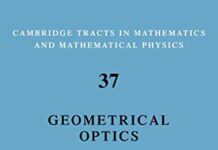
Ebook Info
- Published: 1966
- Number of pages: 505 pages
- Format: PDF
- File Size: 33.26 MB
- Authors: J. L. Synge
Description
User’s Reviews
Reviews from Amazon users which were colected at the time this book was published on the website:
⭐Book was used, was in excellent condition.Book is a classic.
⭐Confession: I had forgotten about this book. I had been reminded of it while studying Dewitt’s Dynamical Theory of Groups and Fields. In that treatise Dewitt mentions (page 149) the so-called “world-function” of Synge. That concept features in Synge’s exposition of general relativity, which is idiosyncratic (and that can be said of many a general relativity monograph). In a review, Peter Bergmann writes: “a very personal account.” (Science, Volume 132, Number 3444, 1960). Thus, Synge will not replace textbook accounts, for instance, it lacks student exercises. However, it will offer new avenues of exploration (not least, due to its extensive sixty-page bibliography). Let us travel a few of those avenues:(1) A quick summary of notation and mathematics is chapter one. That summary runs forty pages. Secure a copy of Synge and Schild, Tensor Calculus, as it elaborates on the background needed for this summary. A bit of Synge wisdom goes far: “We shall avoid the word length.” (footnote, page 3). Synge: “it must be understood that the spaces referred to in generalized Stoke’s theorem are orientable-spaces.” (page 43).(2) Second chapter, World-Function. Read: “it determines the curved world of space-time.” (page 47, also note: Synge retains the hyphen in the word ‘space-time.’ That is good pedagogy). Read Synge: “the world-function is a powerful tool for the execution of systematic approximations without abandoning the techniques of tensor calculus.” (page 48). Parallel transport, introduced (page 59). Note, attention to the conception of parallel propagator: “an essential element of space-time.” (page 64). A highlight is section six, here you will learn of ‘four-dimensional triangulation.’ (page 70).(3) Initial two chapters are mathematical. Third chapter is physics proper, that is, General Relativity. Read: “theoretical physics is, and always will be, a controversial subject.” (page 103). Learn that “the key word in relativity is event.” Synge refers to his fine book on special relativity for more detail. The key point for the entire monograph is this point of view: “for us, time is the only basic measure.” (page 108). Learn the why of that pronouncement in chapter three.(4) Next, Fermi-Walker transport: “it may be said to represent the absence of rotation.” (page 152). Read: “it is necessary to emphasize, that space-time cannot, in general, be split into space and time in any invariant way.” (page 154). Also: “the general theory of relativity is essentially a field theory.” (page 159). We learn: “in curved space-time, we must not add vectors at different points.” (page 165) and “that the energy tensor plays this dual role, inertial and gravitational, is sometimes referred to as the equivalence of inertial and gravitational mass.” (page 174). Another highlight of chapter four: a ten-page discussion entitled ‘ survey of field equations and coordinate conditions.’ Which object to specify ? The metric ? (Synge calls this the g-method) or the stress-energy-momentum tensor ? (Synge calls this the t-method). Of eigenvalues: “the sign of the eigenvalue of the time-component is the most important.”(5) Chapter five again references Synge’s excellent companion volume, Relativity: The Special Theory, as it will come in handy. Gravitational wave equations are introduced and hydrodynamic analogy utilized (page 217). Shock waves briefly discussed. As we have completed half of the text, I only touch on highlights of the remainder of the monograph.(6) Chapter six, conservation laws, is superb. Reading: “as long as we stick to geometry, we do not become involved in such metaphysical questions as the meaning of the word ‘energy,’ for example.” (page 232). Incredibly fascinating is the section entitled “space-time viewed from the Euclidean standpoint.” Read: “it would be possible to develop relativity without the language of geometry.” (page 243). A superb chapter seven expounds upon spherical symmetry. Read: “the concept of symmetry is built into us so deeply that it is hard to explain what it means in words which convey more than the word itself does.” (page 265). Chapter eight will model ‘special universes.’ Learn of Godel’s universe. Learn more of gravitational waves in brief chapter nine. Electromagnetism is next, following which, geometrical optics. Geometrical optics, another excellent chapter, concludes the book.(7) Concluding: As Peter Bergmann writes, this is a very personal account. The book is hardly referenced in other introductory textbooks (e.g., it is not referenced in Zee’s Einstein Gravity in a Nutshell, 2013). But, on a positive note, it is often referenced (as of 2019) in journal literature. Thus, as an introduction, Synge is probably not your first choice. Yet, as a continuing source of relevant material for research, John Synge ranks among the best of them !Therefore, highly recommended.
Keywords
Free Download Relativity : the General Theory in PDF format
Relativity : the General Theory PDF Free Download
Download Relativity : the General Theory 1966 PDF Free
Relativity : the General Theory 1966 PDF Free Download
Download Relativity : the General Theory PDF
Free Download Ebook Relativity : the General Theory



